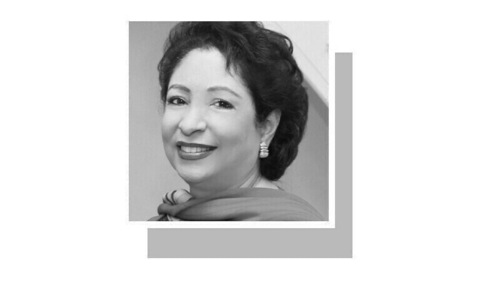THE standards of Urdu have suffered a tangible lapse and we have come to terms with the tragedy. But one’s heart sinks when one listens to some so-called professors of Urdu mispronounce shehr aashob, the well-known and historic genre of poetry. They pronounce it shehr-e-aashob, that is, with an unnecessary izaafat, or the short vowel written as a diacritic mark and pronounced as a short ‘e’ in Urdu, joining the two words. In grammar, this enclitic can be used to form either a possessive case, such as, Rasool-e-khuda (God’s Prophet), or an adjectival phrase, such as, Rasool-e-Kareem (the noble Prophet).
But some websites, too, perhaps taking a cue from the fake professors, erroneously refer to the genre as shehr-e-aashob, giving one yet another shock as well as confirmation that online information about Urdu language and literature may be grossly incorrect. Had they studied a bit of grammar, they would have known that there is a compound in Persian, commonly used in Urdu too, that is known as izaafat-e-maqloob, or the inverted izaafat. In such cases, the words’ sequence is flipped over by putting them in reverse order and the izaafat is abolished. For example, as wrote Abdus Sattar Siddiqi, shehr-e-Iran became Iran shehr. So it was aashob-e-shehr and, using the izaafat-e-maqloob rule, it was reversed to make it shehr aashob, with izaafat gone.
So let us start with the correct pronunciation: shehr aashob. Aashob means turbulence, uproar, calamity or affliction. Hence shehr aashob means, literally, the disturbance of the city’s tranquillity. In literature, it is a genre of poetry that bemoans the ruination or social and economic decline of a city or country and its people. It often draws a picture of a city’s social and economic disorder in a sarcastic or derogatory way.
Dr Syed Abdullah says that contrary to what our lexicographers have written, lamenting the hard times or complaining the unappreciative attitude of a city or country’s people does not make a poem shehr aashob. To qualify as shehr aashob, he says, a poem must reflect upon the social strata of a city or country, especially its working class or professionals. Secondly, it must narrate the disturbance of lives due to a calamity or economic and political breakdown.
According to Syed Abdullah, shehr aashob as a genre originated in Turkey when a Turco-Albanian poet named Maseehi in 10th century Hijri/16th century AD penned a masnavi in a jocular way, lamenting the disturbance of the city of Adrianople’s serenity caused by the ravishing young beauties. It became quite popular and Iranian poets, too, began composing poems that were called shehr aashob and, alternatively, shehr anges, with a distinct lampooning and disparaging tone. Masood Sa’ad Salman Lahori too wrote a shehr aashob. Some Persian shehr aashobs lamented the decline of cities like Herat and Tabriz.
This tradition of Persian poetry was brought to the Indo-Pak subcontinent and shehr aashobs in Persian and Urdu were written here during the Mughal era. Mughal Empire’s decline had begun during the last years of Shah Jahan’s rein, a poet named Bahishti wrote a shehr aashob-e-Hindustan, depicting the princes fighting for the crown and bemoaning joblessness.
In the next phase, after Aurangzeb Alamgir’s death, especially during the Muhammad Shah rule, subcontinent’s political upheaval and economic meltdown is recorded in Urdu’s shehr aashobs. Shehr aashobs written by Jafer Zatalli and Shafeeq Aurnagabadi remind one of those tumultuous days. Circumstances were also conducive for writing shehr aashob and Shakir Naji wrote a piece after Nadir Shah’s attack on Delhi and the consequent disaster the befell Delhi’s citizens. It also satirised the ‘cowardice’ of local forces. Mir Taqi Mir and Nazeer Akberabadi wrote some good samples in the genre. Some shehr aashobs gained popularity for their wit, satire and admirable depiction of the workers and professionals of the city in hard times and lines form Mirza Rafi’ Sauda’s Qaseeda Tazhhek-e-Rozgaar is often quoted as examples in this regard.
After the 1857 debacle, what was depicted through the genre of Urdu shehr aashob was truly Delhi’s tears, says Syed Abdullah. A large number of shehr aashobs portray the tragic yet true historical events. Poets have narrated the lawlessness, moral decay and economic disaster in sarcastic style, with poets sometimes resorting to a tone reminiscent of elegy and dirge.
But writing shehr aashob is not limited to a specific form and a shehr aashob can be composed in any poetic form, for instance, masnavi (two rhyming lines structure), musaddas (six-lined stanzas), mukhammas (five-lined stanzas) and even ruba’i (quatrain).
The question is: today when political and economic turmoil is widespread and our cities like Karachi and Hyderabad have been turned into ruins, why do poets not write shehr aashob? The reason, perhaps, is qit’a, the four-lined poems published in daily newspapers, recording the current affairs in lighter vein.
Published in Dawn, March 31st, 2025














































